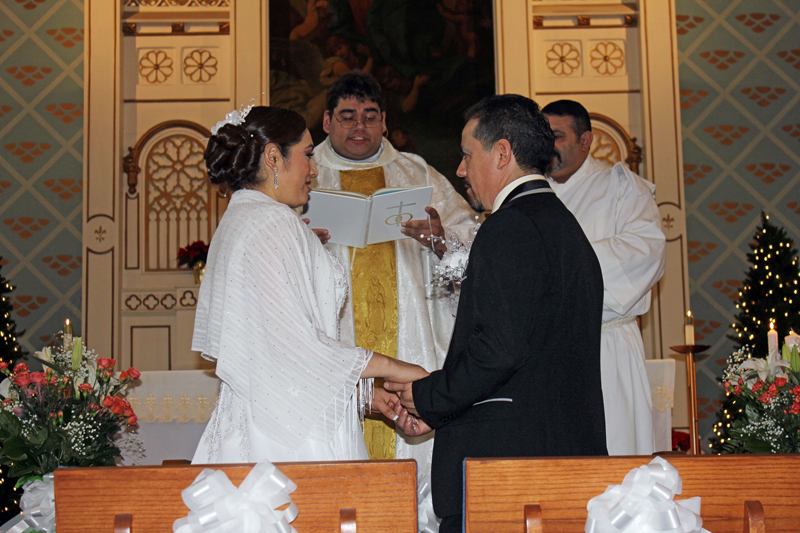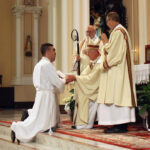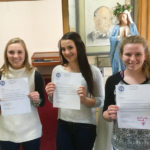By Barb Arland-Fye
The Catholic Messenger
Married 23 years ago in a civil ceremony in Mexico, Maria and Erasmo Herrera radiated joy as they sat in their wedding finery at St. Mary Catholic Church in Davenport, listening to Father Guillermo Trevino’s homily. The spouses chose to make their marriage a sacrament on New Year’s Eve day. They couldn’t help but smile at Fr. Trevino’s reference to “commitment” as an essential element of the sacrament.

Maria and Erasmo Herrera exchange vows during their wedding Mass at St. Mary Parish in Davenport. Father Guillermo Trevino presided at the Mass on Dec. 31. Deacon Gabriel Guerrero (Maria’s uncle) of the Peoria, Ill., Diocese assisted during the Mass. The Herreras were married 23 years ago in a civil ceremony. They decided they wanted to celebrate their marriage as a sacrament.
As working parents of three sons, their commitment to each other and their family remains steadfast. This was the right time to get married in the church, Erasmo said. His wife agreed. Participating in a Friday night charismatic prayer group at St. Mary’s has drawn Maria closer to God. “I wanted for a long time to get married in the church, but that gave me even more reason,” she said. Her uncle, Deacon Gabriel Guerrero of the Peoria Diocese, also provided inspiration. “Bringing my family to Jesus for the sacraments, that’s my concern, that’s my goal,” he said in the sacristy before Mass, preparing to assist Fr. Trevino.
In Mexico, marriage is legalized in a civil ceremony; the church ceremony is separate. Maria was 16 and Erasmo was 18 when they were married in a civil ceremony. They thought about but did not get married in the Catholic Church at that time. Later, they immigrated to the United States.
More than the celebration of the couple, a wedding is a celebration of the church, “a gathering of the faithful to give praise and glory to God. … The couple and the love they share, in a sense, is the lens that helps us to fix our gaze on Christ,” states the Davenport Diocese’s policies on matrimony. That’s what Maria and Erasmo desired.
Planning for the wedding Mass began several months ago, Maria said. The couple set the date after confirming that her mother and his parents from Mexico would be able to attend. The timing of the Mass coincided with the newly promulgated Order of Celebrating Matrimony: Second Edition. It provides for two adaptations important to Hispanic and Filipino cultures: the blessing and giving of the arras (coins) and the blessing and placing of the lazo.
“We have always done them,” said Father Joseph Sia, referring to the arras and lazo blessings. “What has changed is that these customs were formally adopted and published in the rites approved by the U.S. Conference of Catholic Bishops,” added the priest, pastor of St. Joseph Parish-Columbus Junction and sacramental minister of St. Joseph Parish-West Liberty.
During the entrance procession on the wedding day, Erasmo’s parents escorted him down the aisle of the church where he waited for Maria. Her brother, Antonio, and her mother, Elvira, accompanied Maria down the aisle. She, too, would have had both parents accompany her, but her father is deceased.
Family came from the Midwest and Mexico to witness Maria and Erasmo’s celebration of marriage during the Mass conducted in Spanish. Also present were their three sons, Erasmo Jr., 22; Fred, 20; and Yair, 3. The youngest called out for his mommy before a smiling Fred scooped up the little boy and took him to the back of the church.
In Mexico, a Catholic wedding includes the participation of padrinos (godparents) from both sides of the family. They participate in the blessing of the arras and the lazo, as well as the rings, the Bible and the rosary, Maria said.
“They always use a godfather from one side of the family and one from the other side of the family. That’s what creates the union,” explained Fred.
The blessing and giving of the rings and the arras took place after the homily, during the Celebration of Matrimony. After Fr. Trevino blessed the rings, the padrinos (two of Maria’s uncles) presented the small box of 13 coins (arras) to the priest to be blessed. He gave the box to Erasmo who poured the coins into Maria’s hands. She poured them back into his hands. Their exchange symbolized an appreciation for God’s bestowal of gifts on them.
During the preparation for Communion, Erasmo’s baptismal godparents draped a crystal lazo over the spouses. The lazo resembles a large rosary in the shape of a figure eight. It, too, symbolizes the indissoluble marriage union the couple makes with God’s help, says Father Paul Turner in “One Love.”
The couple’s two older sons were happy to see their parents married in the Catholic Church. “I know it’s wonderful for them,” Erasmo Jr., said. “They are a great couple.” “I think it’s great for them to get married in the church,” Fred added.
For Elvira, witnessing the marriage of her daughter and son-in-law was an answer to prayer. A week after the wedding she sat in the couple’s living room, gesturing her gratitude with her hands and voice. “She said she is very happy because her daughter got married in the church,” Fred said, interpreting for his grandmother. “She always prayed to herself that my mom would spend the rest of her life with my dad.”











